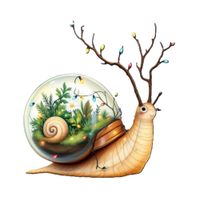Collembolans, also known as "springtails," are primitive apterygote (wingless) insects. They are called springtails because they have a spring-like lever called a furcula, which is folded under their abdomen. When released, the furcula pops the tiny insect into the air, sometimes as high as several inches.
Springtails represent the largest of the three lineages of modern hexapods that are no longer considered insects. Unlike insects, which have external mouthparts, springtails have internal mouthparts. Other differences include variations in how they moult, reproduce, and the extent to which their muscles and antennae are developed.
Springtails are cryptozoa (small animals that live in dark, damp environments) and are frequently found in leaf litter and decaying organic material, where they are primarily detritivores and microbivores. They play a crucial role as biological agents for the control and dissemination of soil microorganisms. Springtails are typically less than 6 mm long, have six or fewer abdominal segments, and possess a tubular appendage called the collophore or ventral tube. This appendage has reversible, sticky vesicles that project ventrally from the first abdominal segment.
Did you know that springtails can reduce their body size by as much as 30% through a process called subsequent ecdysis (moulting) when temperatures rise high enough? This shrinkage is genetically controlled. Since warmer conditions increase metabolic rates and energy requirements, the reduction in body size provides a significant advantage to their survival.
Life Cycle
Springtails reproduce quickly, going from egg to adult in as little as four to six weeks. Mature males leave packets of sperm cells in the soil, where they live. Females pick up these packets as they lay their eggs, either in groups or singly. Depending on the temperature, the eggs can hatch within five to ten days. Nymphs resemble the adults, and during their five or six weeks as nymphs, they undergo several moults, becoming larger with each stage until they reach adulthood.
Importance in Bioactive Terrariums
Springtails are among the most important members of any cleanup crew in a terrarium, providing a wide range of benefits to the ecosystem. Some of their key roles include:
- Breaking down decaying plant matter, fungus, and other organic material, converting it into nutrients that plants in the terrarium can absorb.
- Feeding on mould and fungus, helping to prevent their proliferation and maintaining a healthy, balanced environment.
- Aerating the soil, which improves soil structure and allows for better air and water circulation.
- Playing a vital role in nutrient cycling, ensuring that essential nutrients are continuously available to plants.
- Serving as a valuable food source for other terrarium inhabitants, such as small amphibians, reptiles, and invertebrates, contributing to the overall food chain.
This makes springtails the perfect addition to any terrarium, as they help control the spread of mould and decompose dead organic matter. By processing this material into nutrients for live plants, springtails help create a self-sustaining ecosystem—what’s known as a bioactive terrarium.
